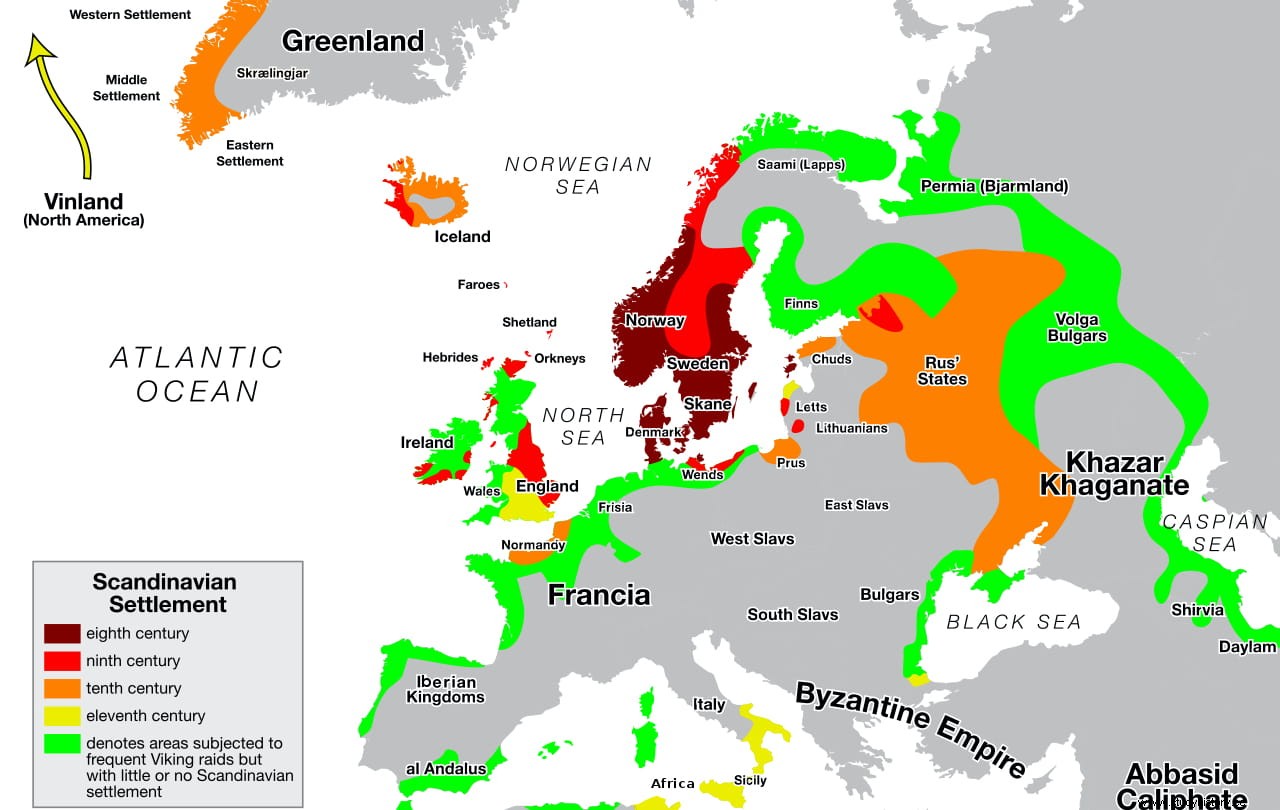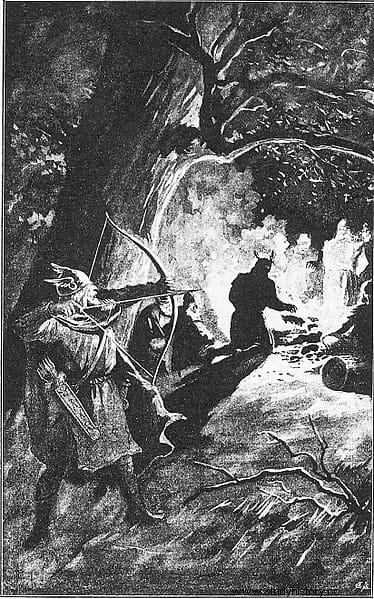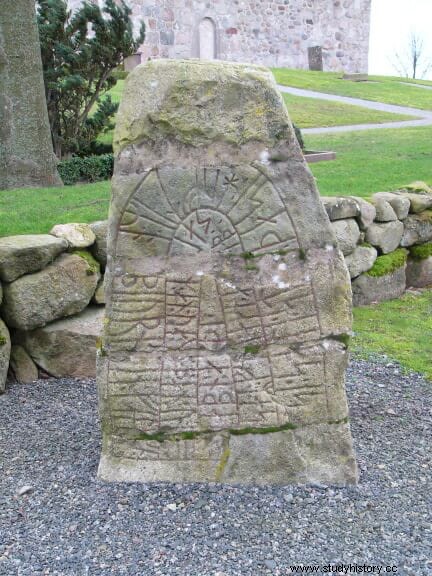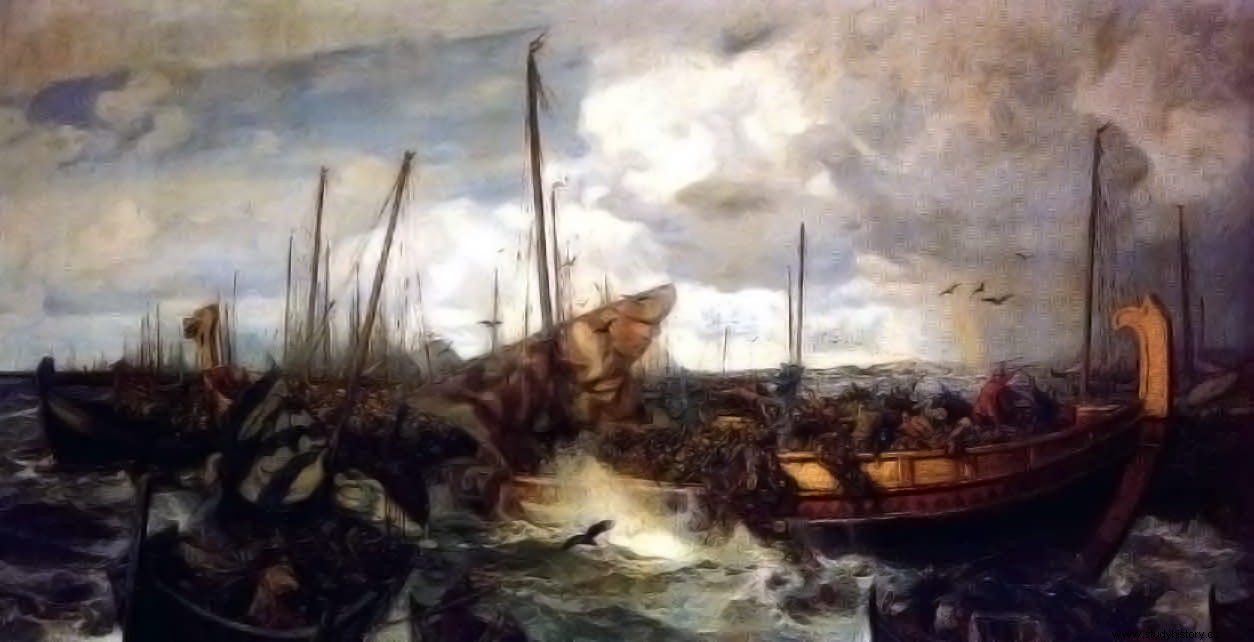Within that reality halfway between history and legend told by the Viking sagas, the world of warriors occupies a special place. It is true that at this point we already know that these peoples did not spend their lives looting after looting, but that such actions corresponded to a mere complement to their economy, fundamentally commercial but also agrarian, their famous incursions being something of a seasonal nature, without too many differences with those made in almost all of medieval Europe by both Christians and pagans. But it is also true that, as in the epic tales and other epic stories, the sagas focus their attention on this war facet, and one of the most interesting in this sense is the so-called Jomsvikinga .
The title comes from combining the term Viking (whose etymology is controversial but seems to allude to the aforementioned expeditions, to the settlements where the Nordics lived or to their geographical environment) with the proper name Jomsborg, a fortress that would be located in the Baltic Sea and in which was inhabited by a brotherhood of Viking mercenaries who consequently became known as jomsvikings . The place is mentioned in several lausavísur (skaldic poems) and in the aforementioned saga, but also in that of Olaf Tryggvason (king of Norway in the late 10th century who grew up in Russia and tried to spread Christianity in his country) and in the Book of Flatey (Codex Flateyensis o Flateyjarbók ), a 14th-century Icelandic manuscript with later additions.

Nor could it be missing from the indispensable Gesta Danorum , by Saxo Grammaticus, who calls this enigmatic enclave Julinum, explaining that its conqueror, the Danish king Harald Blåtand, later ceded it to the Swedish prince Styrbjörn the Strong . The saga Knýtlinga (a chronicle of Danish monarchs written in the 13th century), endorses that view, as does the Styrbjarnar þáttr Svíakappa and the Eyrbyggja . Instead, the Jomsviking saga attributes its foundation to Palnatoke, after receiving the land from the sovereign Vendo Burislav. Vendo was the name given by the Germans to the North Slavs, especially the Sorbs, and Burislav, whom some identify with the Pole Boleslaus I, was their monarch between 965 and 1025 AD
As for Palnatoke, it was as Tord Palnason was popularly known, a Danish hero, chieftain of the island of Fyn, who convinced Prince Svend of Denmark to take up arms against his father, the aforementioned Harald Blåtand, in defense of religion. ancestral. Of course, Palnatoke had his own reasons for hating the monarch, because the latter, according to the historian Saxo Grammaticus, forced him to shoot an arrow at an apple placed on the head of his son while the boy had to run down a hill; This story will be familiar to more than one because of the Swiss version, that of William Tell, since it is a classic episode that is repeated in the legends of the regions of Germanic culture.

As always, it is very difficult to differentiate the true from the fantastic, especially considering that all the sources are later -except for the three runestones of Högby, Hällestad and Sjörup- and no material evidence of the existence of Jomsborg has been found. nor its exact location, beyond deducing that it was in what is now Pomerania. But the idea of a warrior brotherhood whose members were guided by a code, just as military orders would do in other parts of the continent shortly after, is very attractive.
Moreover, it was not a unique case and it is worth remembering the berserkers , the warriors who fought in a kind of furious trance (if they really existed), or the huscarls , the professional soldiers who formed the royal guards. Thus, many Vikings were grouped into the generically called vinkinge-lag , each one with its regulations and that when summer arrived (end of the agricultural season) they offered their services to the jarls to reinforce the expeditions they planned.

However, the interpretations of Jomsborg in particular vary quite a bit and there are those who believe that in reality it would not be more than a part of the Danish army made up of vendors, who in those days had a great role. Facing the Jomsviking saga , which considers all jomsvikings to be vikings , the Styrbjarnar þáttr Svíakappa he insists on this mixed composition when he recounts that among those men there were many from the East. Harald Blåtand himself married a Venda princess, teaching her people the Viking secrets of navigation that enabled them to raid places like Hamburg, Brandenburg, and Holstein.
Due to this ethnic multiplicity, although the brotherhood was pagan and maintained the cult of the two great gods of Scandinavian mythology, Odin and Thor, it could admit jomsvikings of other faiths. Being mercenaries, the first thing was the business and therefore they had no problem putting themselves at the service of even Christian gentlemen; In that, too, they did not differ from the usual cases in other European corners, such as the Cid's army, which was hired by Al-Muqtadir, king of the Taifa of Zaragoza.

And that according to the Jomsvikinga saga the selection process for candidates was thorough, requiring them to be between eighteen and fifty years old (only a twelve-year-old boy named Vagn Åkesson, Palnatoke's grandson, broke that pattern by defeating the veteran Sigvaldi Strut-Haraldsson), to be of proven bravery and to submit to a holmgang , that is, a duel (in this case of an initiatory nature), with a jomsviking . By the way, the saga says that the episode of the apple of Palnatoke with his son was precisely an entrance test.
Once admitted, the rookie had to swear to the aforementioned code, which included typical precepts:not to fight with the other brothers either physically or orally (a superior mediated in the discussions), defend them and avenge their death, show no fear in combat, withdraw alone before a superior enemy, distribute the spoils among all, not be taken prisoner, not be absent for more than three days from the fortress without authorization, not have relatives living in it (it is unknown if he could have them outside) and suffer expulsion for the rupture of any of these rules.
Insisting on the fortress, his base of operations, some point out that it was on the Silberberg hill on the island of Wolin, a piece of land of two hundred and sixty-five square kilometers located on the Polish Baltic coast and on which he also The legendary city of Vineta has been located, a Slavic commercial center that according to tradition sank in the waters when rejecting Christianity but that, if it existed, was probably destroyed by a Viking raid in the 12th century. As there is no archaeological record of Vineta either, the defenders of its existence identify it with Jomsborg itself, which would have been built on top of it. According to some accounts, in its heyday Jomsborg had a capacity for between thirty and three hundred ships in its port; if we take the small amount as more reliable, this would mean a number of warriors that would range between nine hundred and two thousand.
The raids of the jomsvikings they developed throughout the 10th and 11th centuries, with interventions in the wars between Norway and Sweden due to dynastic disputes between the years 984 and 986. Now, after the golden age lived in the times of Palnatoke, Styrbjörn the Strong , Svend I of Denmark, Sigvaldi Strut-Haraldsson and Thorkell the Tall , things have changed. It was said that the penetration of Christianity would have weakened the brotherhood, which is inaccurate because, as we said before, Harald Blåtand had already converted in the year 965.

But the idea that prevailed was that, we will see below. The jomsvikings they suffered serious defeats at the battles of Fýrisvellir and Hjörungavágr. In the first, dated around 984 or 985, Styrbjörn the Strong fell before his uncle Eric the Victorious when trying to snatch the crown; according to tradition, the latter benefited from an ad hoc pact who signed with Odin. In the other contest, a year or two later, the jomsvikings they were defeated by Håkon Sigurdsson of Norway and it was their end, although they had the swan song in one last fight, that of Svolder, in the year 1000, under the command of the jarl Sigvaldi Strut-Haraldsson, when Olaf of Norway was left alone causing the disaster of his fleet, presumably because of his Christianity.
The survivors still had the strength and morale to carry out expeditions through England, Normandy and other northern territories at the beginning of that 11th century, possibly becoming the base of the Tinglith , the personal guard of Cnut the Great . However, in 1043, the Norwegian king Magnus I decided to put an end to them for good and attacked Jomsborg, sacking the city, demolishing the fortress beyond trace and executing the survivors. Perhaps he is to blame for the doubts that assail us now on the subject.
